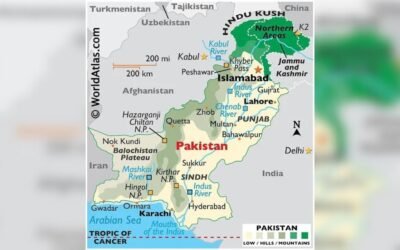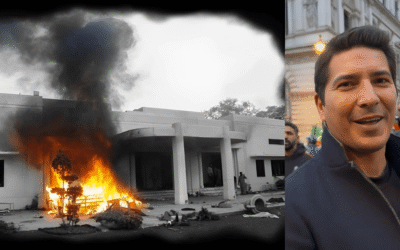Pakistan contributes less than 1% to global greenhouse gas emissions. Yet, it is ranked as the fifth-most vulnerable country to climate disasters globally. The 2022 floods were a stark reminder: they inundated a third of the country, affected over 33 million people, killed over 1,700, and caused $30 billion in losses.
The country faces:
- Extreme Heatwaves: Record temperatures have caused glacial lake outburst floods (GLOFs).
- Erratic Monsoons: Heavy rainfall events have become more frequent.
- Floods and Droughts: Recurrent devastating floods and prolonged droughts.
- Sea Level Rise: Historically, sea levels along the Karachi coast have risen by 1.1mm per year, accelerating to 3.6mm per year between 2006 and 2015.
The severity of these impacts means that climate change is an unfolding crisis, not a distant threat.
The “Green Pakistan” Vision
In response, Pakistan launched the Green Pakistan Initiative (GPI) and the flagship 10 Billion Tree Tsunami program. The GPI is a comprehensive initiative aimed at combating climate change, protecting the environment, and ensuring food security.
Its goals include:
- Reforestation: Planting trees to increase forest cover, which is alarmingly low at 4-5 percent of total land area.
- Sustainable Agriculture: Modernizing farming practices and making arid land productive.
- Economic Growth: Creating jobs and promoting green development.
The government has also implemented Climate Budget Tagging (CBT) to classify climate-related spending. For FY 2025-26, 6.9 percent of the budget and 8.2% of the development budget were allocated for climate initiatives.
Afforestation Efforts: Promises vs. Reality
The 10 Billion Tree Tsunami (BTTAP) has garnered international attention and praise. Launched in 2014, it aims to plant or regenerate 10 billion trees. By June 2023, the program reported covering 4 million acres with indigenous species and creating over 63,000 jobs. In Khyber Pakhtunkhwa, the initial “Billion Tree Tsunami” phase (2014-2017) resulted in a net increase of 300 km² in tree cover by 2020.
However, critics argue that despite grand slogans, deep-rooted commitment is often lacking:
- Poor Planning: Many plantation drives are poorly planned, lack ecological sensitivity, and often introduce exotic or non-native species that harm local ecosystems.
- Survival Rates and Monitoring: There is often insufficient monitoring of tree survival rates.
- Funding Gaps: The budget for forest programs has sharply declined from Rs 14 billion during the Billion Tree programme years to Rs 2.4 billion today.
- Audits and Transparency: The Auditor General of Pakistan (AGP) was tasked with auditing the Billion Tree Tsunami project to ensure transparency; however, the audit outcomes are not always widely publicized.
- Deforestation Continues: Deforestation, urban encroachment, and illegal logging persist, negating some plantation efforts.
Disaster Preparedness Operations
Pakistan has institutions like the National Disaster Management Authority (NDMA) and Provincial Disaster Management Authorities (PDMAs). They are responsible for preparedness, response, and recovery.
- Institutional Framework: NDMA and PDMAs have a framework for disaster management. They develop early warning systems, conduct risk assessments, and organize training.
- Capacity Building: The NDMA claims to have improved its capacity in urban rescue and other disaster response areas since the 2005 earthquake.
- Recent Responses: Following the 2022 floods, the NDMA/PDMA initiated relief and reconstruction efforts.
Former Climate Change Minister Sherry Rehman warned in 2023 that rising temperatures in Gilgit-Baltistan and Khyber Pakhtunkhwa were increasing the risk of flash floods and glacial lake outburst floods, urging local administrations and communities to remain vigilant and take precautionary measures.
However, the effectiveness of these operations faces severe scrutiny:
- Expertise Gap: NDMA and PDMAs often rely on generalist personnel, lacking specialized expertise in disaster management or climate resilience. Highly qualified professionals are often underutilized. This leads to inefficient interventions.
- Coordination Issues: These bodies often lack coordination, expertise, and suffer from poor governance.
- Reactive, Not Preventive: The national approach remains more reactive (responding after a disaster) rather than truly preventive.
- Insufficient Early Warning: A lack of early warning systems and evacuation planning persists outside major cities.
- Budget Cuts for Preparedness: The budget for disaster preparedness was recently cut by 30%, while post-disaster rehabilitation increased by 157%. This suggests a focus on cleaning up after disasters, rather than preventing them.
- Infrastructure Vulnerability: Flood protection schemes suffer from maintenance issues, and new houses are rebuilt without “climate proofing” (like raised foundations).
Challenges and Gaps
Pakistan’s climate plans face systemic challenges that often turn ambition into an “empty slogan”:
- Implementation Gap: A significant gap exists between the formulation of climate policy and its practical implementation. Policies often remain theoretical, and there’s a lack of funding and clear authority for implementation.
- Resource Strain: Natural hazards strain already limited resources, disrupt livelihoods, and displace millions.
- Economic Priorities: Climate initiatives often take a backseat because of urgent financial problems like poverty, unemployment, and power shortages. Measures such as carbon taxes on fuel are seen more as ways to generate revenue than real efforts for climate change.
- Political Will: Political leaders often treat environmental protection as a symbolic act rather than a vital national priority.
- Community Engagement: Formal community training and preparedness are limited, despite local awareness of risks.
A documentary by DW News captures the sheer scale of Pakistan’s 2022 climate catastrophe, showing how one-third of the country was submerged, displacing millions and amplifying calls for urgent climate resilience.
The Way Forward
To move from “empty slogan” to “Green Pakistan,” a fundamental shift is needed:
- Prioritize Climate Finance: Invest significantly more in climate adaptation and mitigation, ensuring transparent use of funds.
- Bridge Expertise Gap: Recruit and empower specialized experts within disaster management bodies (NDMA, PDMAs).
- Strengthen Prevention: Shift focus from post-disaster rehabilitation to robust preparedness and early warning systems.
- Science-Based Reforestation: Implement a national reforestation strategy grounded in science, using indigenous species and proper monitoring.
- Community-Led Resilience: Support local communities and civil society organizations in taking the lead on green projects and disaster preparedness efforts.
- Policy Implementation: Ensure clear mechanisms for policy implementation, coordination between federal and provincial levels, and consistent monitoring.
The climate clock is ticking for Pakistan. Without real, ongoing effort and a move from talk to action, the goal of a Green Pakistan might stay just a promise, leaving millions exposed to an increasingly severe climate reality.
References
- Anadolu Ajansı. (2025, February 12). Pakistan ranked as most vulnerable country to climate change in 2022. Retrieved from
- Amnesty International. (2025, May 6). Pakistan: Climate disasters increasing risks of death and disease amongst children and older people – new report.
- The Spine Times. (n.d.). Green Pakistan Initiative for a Sustainable Tomorrow.
- The IGC. (2025, July 2). Evaluating the environmental impacts of large-scale afforestation in Pakistan.
- Republic Policy. (2025, July 14). Climate Vulnerability and the Reforestation Void in Pakistan.
- PreventionWeb. (2014, April 3). Analysis: How effective is Pakistan’s disaster authority?.
- NIPA Peshawar. (n.d.). Bridging the Expertise Gap in Pakistan’s Disaster Management Institutions. Retrieved from
- ReliefWeb. (2025, January 17). Navigating climate change, disasters and displacement in Pakistan: a case study of Rahim Yar Khan.
- UNEP GRID. (n.d.). Climate change / Pakistan | Interactive Country Fiches.
- Asian Development Bank. (n.d.). Climate Change Profile of Pakistan.
- PDMA Sindh. (n.d.). Frequently Asked Questions.
- PDMA KP. (n.d.). Provincial Disaster Management Authority. Retrieved from
- Scipedia. (2025, June 12). A Critical Analysis of Pakistan’s 2021 National Climate Change Policy: Ambition vs. Implementation.







